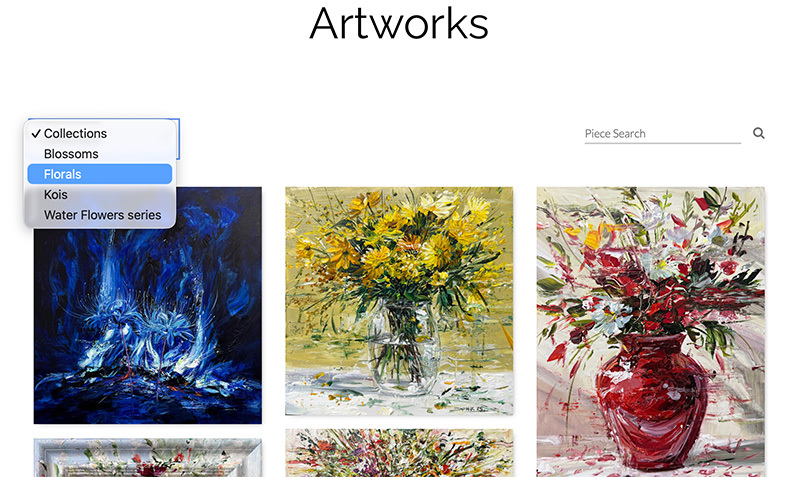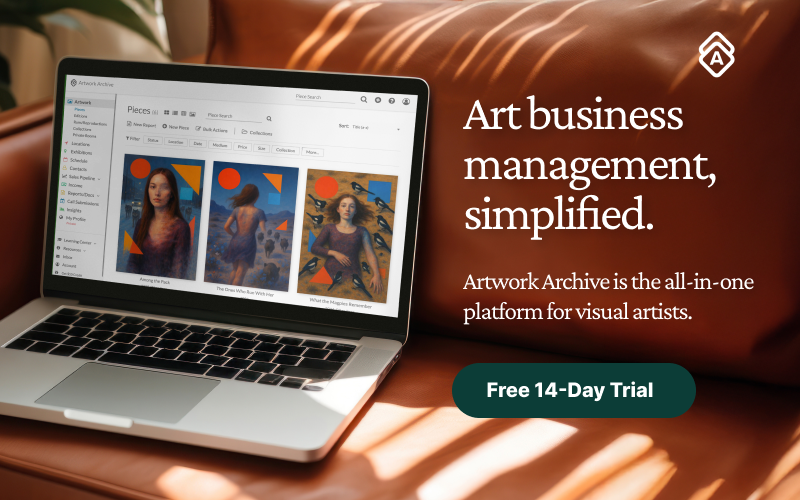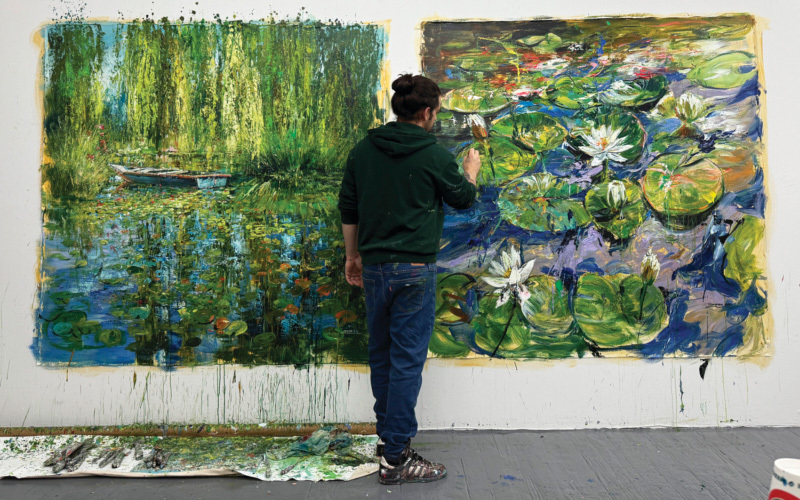 Featured Artist Eric Alfaro is enthralled by beauty that is destined to fade away. Image courtesy of the artist.
Featured Artist Eric Alfaro is enthralled by beauty that is destined to fade away. Image courtesy of the artist.
“I love making art because I’m fascinated by the beauty and energy of nature.”
For Eric Alfaro, every subject in nature carries its own message.
Flowers hold fragility and renewal.
Koi carry rhythm and vitality.
Plants bring their own quiet strength.
Together, they shape a practice rooted in life’s constant movement and change. Eric paints with a loose hand, letting paint drip and textures form so the surface of the canvas feels alive. His work draws on the long tradition of artists celebrating nature while carrying the freshness of contemporary painting.
Each piece becomes a way to pause: a vase of flowers recalling a morning memory, koi circling in water like time slowing down.
When it comes down to it, Eric's paintings carry forward what first drew him in: the beauty of nature in motion, the homage to art history, and the simple joy of translating it all into paint.
Read on to discover what inspires Featured Artist Eric Alfaro, how he creates his energetic works, and the tools that help him keep his practice organized and his career moving forward.
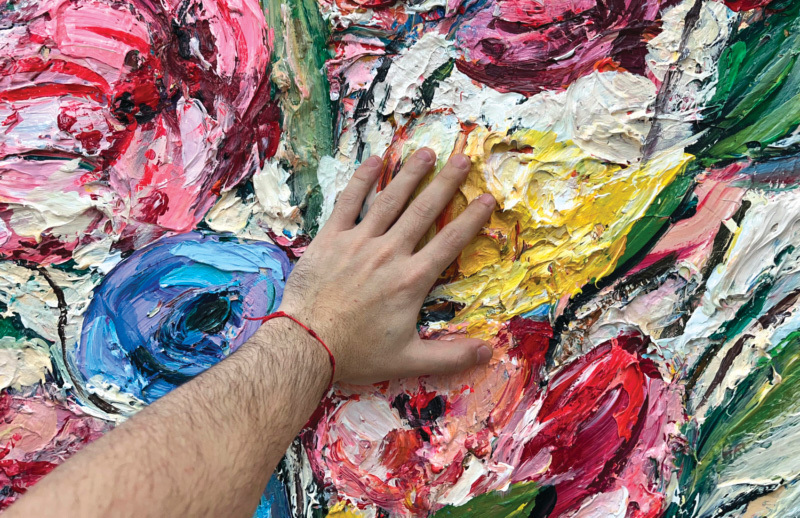 Eric's art begins with a recognition that everything around us is always in motion. Image courtesy of the artist.
Eric's art begins with a recognition that everything around us is always in motion. Image courtesy of the artist.
Picturing Fragility and Resilience
Originally from Cuba and now based in the United States, Eric has built his practice around capturing the paradoxes of existence: beauty that fades, energy always in motion, and the never-ending patterns of death and renewal that define the natural world.
“With flowers, I find a language of fragility and resilience,” he shares with Artwork Archive. “They bloom every year and then vanish, yet their cycle is eternal.”
His canvases burst with color and movement, whether depicting delicate florals or the sinuous forms of koi fish swimming through water. But beneath the bravura handling of paint lies Eric’s ongoing meditation on impermanence and transformation.
“Painting allows me to represent that fleeting moment, life itself and also its impermanence,” he explains. “Each piece becomes a way of remembering that paradox: beauty that insists on existing even though it won’t last.”
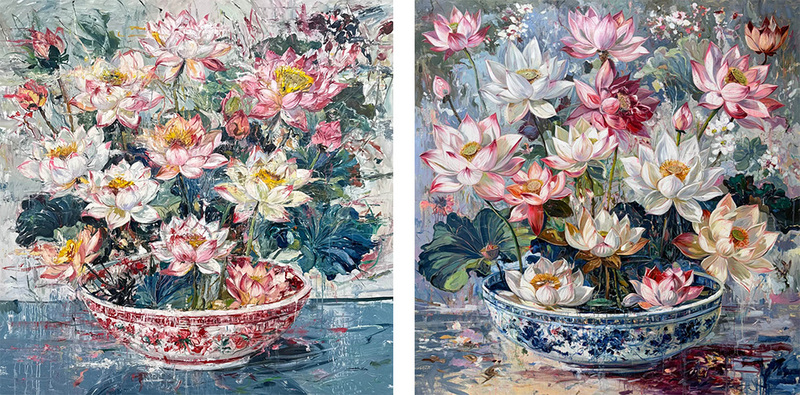 Eric Alfaro, Wait for me, 2025, Oil On Linen, 78 x 78 x 2 in, and Rising, 2025, Oil On Linen, 80 x 80 x 2 in.
Eric Alfaro, Wait for me, 2025, Oil On Linen, 78 x 78 x 2 in, and Rising, 2025, Oil On Linen, 80 x 80 x 2 in.
The Inspirations That Fuel Eric’s Art
“It is impossible for me to paint florals without feeling the influence of traditions that came before me,” Eric confesses.
In his practice, he takes inspiration from two very different painting traditions that—brought together on his canvases—yield a synergy that draws on both without being confined by either.
“The Japanese and Chinese ink painters who mastered plum blossoms, magnolias, and cherry trees” remain a powerful influence for Eric. "Their works are not simply botanical, they are meditations on time, on renewal, on the cycles of life.”
Yet he also feels a deep connection to Western modernists who imbue the natural world with personal and emotional meaning. When an artist like Vincent van Gogh paints a vase of flowers, or an almond tree’s blossoms in spring, Eric views these as celebrations of birth and renewal. But under these celebrations lies an abiding melancholy that comes from the transience of all natural things. “These references live quietly within my practice as presences to learn and admire,” Eric offers.
This dual inheritance can’t help but shape Eric’s technical approach. “I situate my work between these worlds,” he reveals, “carrying the gestural spirit of East Asian traditions and the materiality of Western impasto.”
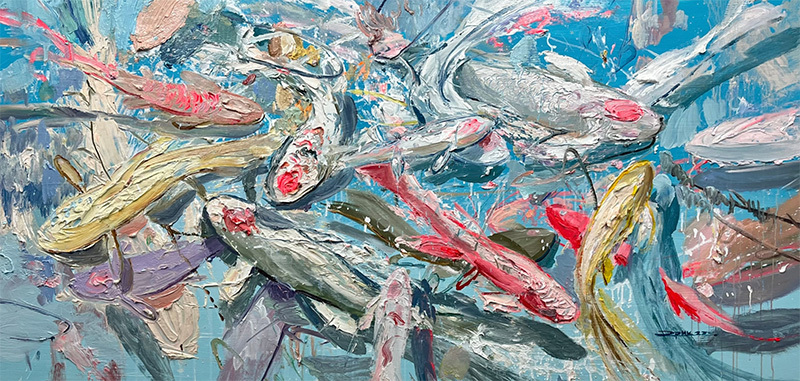 Eric Alfaro, The sound of water, 2023, Acrylic On Linen, 40 x 80 x 2 in.
Eric Alfaro, The sound of water, 2023, Acrylic On Linen, 40 x 80 x 2 in.
Capturing Motion Through Paint
If flowers represent the tension between fragility and persistence in Eric’s art, his paintings of koi fish represent the constant motion of energy through all living things.
For Eric, “koi speak about movement and flow. Energy, persistence, and transformation.”
That energy symbolized in the koi shows up on the canvas through the vivacious brushstrokes Eric lays down: “Watching them swim is like watching a lot of energy move through water, sometimes calm, sometimes chaotic, always alive.”
This focus on energy and movement brings to life his interest in how even the most static blossom is in the process of becoming a flower, which is in the process of dying away, only to be reborn the following spring. That ebbing and flowing energy of life is behind all his creations.
Looking at Eric’s paintings, you feel them pushing forward, circulating, refusing to settle into stillness. "When I paint koi, I’m trying to paint the rhythm and vitality, the current that keeps us going,” he remarks.
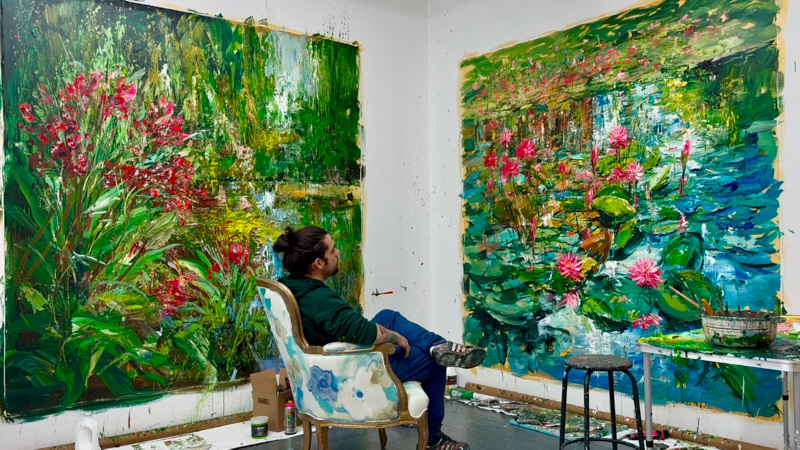 Eric likes to work in series, so that an idea he works with in one painting can reveal new facets in another. Image courtesy of the artist.
Eric likes to work in series, so that an idea he works with in one painting can reveal new facets in another. Image courtesy of the artist.
Painting in Series to Dive Deeper
Eric’s creative process reflects his philosophical approach to painting. When he finds a theme worth exploring, he likes to work through it over time, allowing the ideas to evolve and deepen.
“In my work process, I almost always work from series,” he shares. “At some point an idea comes to me that I find interesting and I like to develop it in as many works as possible.”
A single painting of a flower might be engaging, but a series of flower paintings can become an investigation into what the flower represents, how they function as symbols, and what they might reveal about existence itself.
To keep this line of inquiry consistent, Eric likes to end each day with a thread for the next. While he’s resting from a day of painting, he lets his subconscious mind deal with any issues he’s facing in the studio. The answers that can then appear to him the next day can be revelatory.
“I almost always start the pieces with an idea from the day before or several days ago,” he says. “This allows me to delve into the subject and try to understand it, developing the idea little by little over time.”
Start Each Day With Fresh Inspiration:
If you want to pick up your art thoughts where you left them yesterday, try using Artwork Archive's Notes feature to track your artworks' progression. You'd be surprised the insights you can gain by taking notes throughout your creative process.
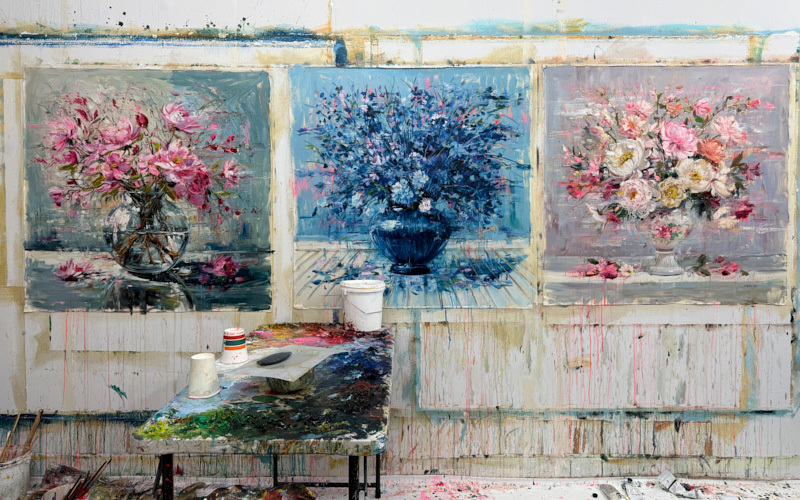
Image courtesy of the artist.
Being a Painter Is About So Much More Than Painting
For Eric, mastering his medium was only the first step on his journey to becoming a working artist. That’s because the contemporary art world demands a range of skills far beyond brushwork and color theory.
He quickly learned that to get where he wanted to go, he had to learn how to photograph his work, how to edit videos of him in the studio, and he had to develop a clear understanding of how social media algorithms work “so that my work has more reach.”
This litany of extra technical skills can seem like a second full-time job that artists must master alongside their actual art practice. The romantic vision of the starving artist alone in the studio has been replaced by a more complex reality.
But, thankfully, the outreach that artists must do today to further their careers also allows for more points of connection with the outside world, and hopefully, more satisfaction as well.
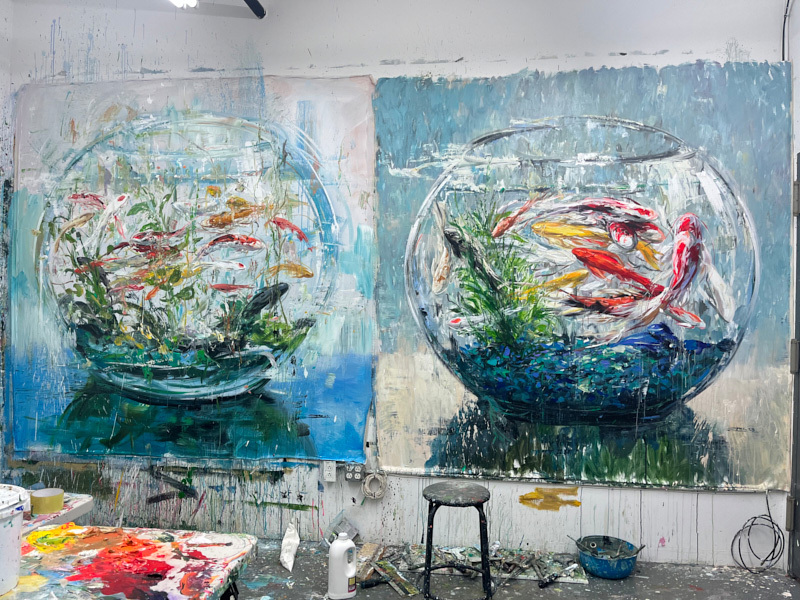 For Eric, koi fish represent the underlying current that keeps us all going. Image courtesy of the artist.
For Eric, koi fish represent the underlying current that keeps us all going. Image courtesy of the artist.
Discovering an Art Business Platform That Worked
With a robust back-catalog and a growing number of additional assets that needed tracking, Eric was finding his existing organizational systems lacking.
“I used to store images of my work on computers or hard drives, which was quite risky in case the information is lost,” he recalls.
“It was also very difficult for me to keep my inventory organized by year, series, or date,” he explains. But then he found a tool that could solve all these problems: "Artwork Archive gives you that possibility in a very organized way.”
As he started filling out his inventory in Artwork Archive, Eric discovered that the tools were making his practice—from categorizing to sharing to registering sales—easier and more efficient. "It seemed perfect for what I was looking for, and made it possible for me to have immediate access to my work, in addition to keeping it in order and stored safely online. I love it!”
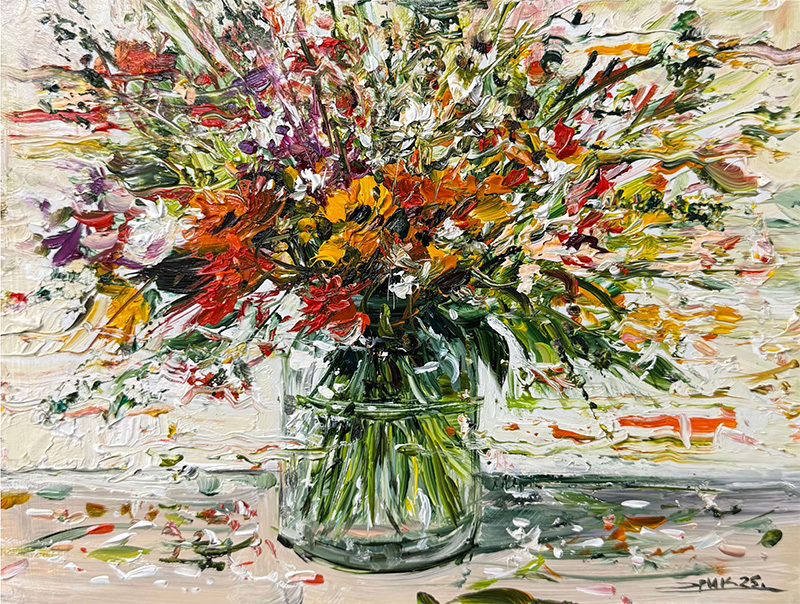 Eric Alfaro, Garden in a vase, 2025, Acrylic On wood panel, 9 x 12 x 2 in.
Eric Alfaro, Garden in a vase, 2025, Acrylic On wood panel, 9 x 12 x 2 in.
An Organized Artist Is a Successful Artist
Now, five years on from starting to use Artwork Archive, Eric is making full use of all of the platform’s art business tools.
“What I like most is the organization and the fact that I can immediately upload my work online from my phone to my website,” he shares.
Because Eric has embedded his Artwork Archive Public Profile on his personal website, changes he makes to his Inventory automatically update on his website. “It's a mirror of Artwork Archive.”
Eric has also been able to create Collections out of his series, including his Blossoms, Flowers, and Koi Collections. This allows him to show to collectors and curators that these groups of paintings build meaning through their relationships to each other.
I can organize which series to show or which paintings to display to the public, very quickly and securely.
For an artist juggling the many technical demands of contemporary practice, this kind of streamlined approach to his inventory has created valuable mental space. Time not spend on redundant data entry can become time available for actual painting.
Impress Collectors With Personally Curated Work:
With Artwork Archive's Collections, you can create custom groupings of your works, tailored to specific audiences or just to collect similar works together. Give it a try today!
Eric’s Advice For Aspiring Artists
Ultimately, Eric didn’t become an artist to mess around with spreadsheets and social media. He became an artist to explore his creative intuition wherever it might take him. And now that he has the admin side of his practice under control, he has the space he needs to let that intuition take the lead.
“Art is a very difficult career, but the spiritual fulfillment it gives makes it worthwhile; it's a truly beautiful practice,” he reflects.
As Eric has learned to observe nature as it unfolds, rather than as a static state to be captured, he has come to see similarities to the flowing life of an artist. Because in the end, every artist must find meaning in the process of creating artworks, rather than relying on external outcomes to fuel their practice.
If he was giving advice to an aspiring artist, Eric would tell them not to follow fads. Instead, always make art that you want to see in the world. “Work hard,” he urges, “and believe in your inner voice.”
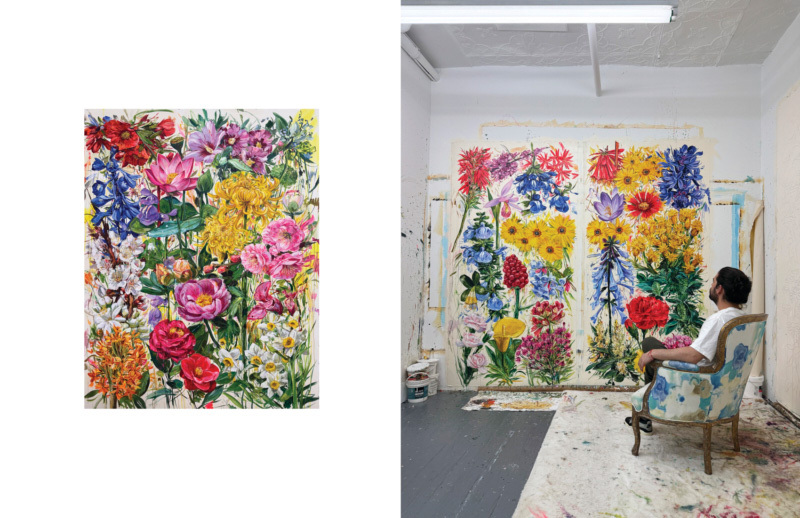 Don't follow fads, Eric advises—follow your heart. Images courtesy of the artist.
Don't follow fads, Eric advises—follow your heart. Images courtesy of the artist.
No matter where you are in your art journey, getting your business side in order doesn’t have to feel overwhelming. A bit of structure now can mean more time and headspace for the work you actually want to be doing.
Artwork Archive helps artists build an online portfolio, stay on top of their inventory, and create things like tear sheets and invoices in just a few clicks. Start a free trial and see how it fits into your own process.
